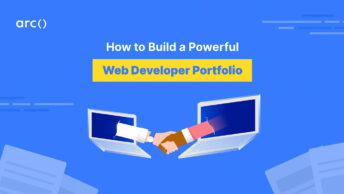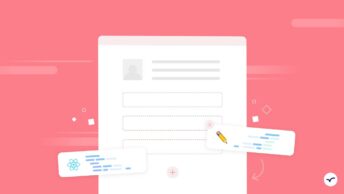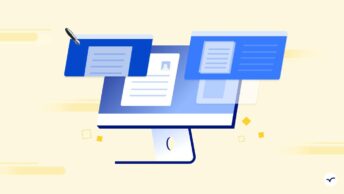What do you need to land your dream full stack developer job?
First of all, you’ll need technical skills. It’s skills like application architecture, front-end and back-end programming languages, databases, version control, and more that enable you to do the job, after all.
Then you probably also need some experience to show hiring managers that you can actually do the job. Now, this could be anything from on-the-job experience, or, if you lack this, some freelance or passion projects you’ve worked on before.
And between all this, you shouldn’t forget your education credentials — or your story if you’re self-taught.
The thing is, you sometimes get so caught up with all these requirements that you forget about a vital requirement to land your dream job: a stellar full stack developer resume. After all, it’s your resume that presents all this information to hiring managers in a way that speaks to the quality of your work and the expert skills you’ll contribute.
But where do you begin? Fortunately, we’re here to help. In this post, we’ll show you how to write an effective full stack developer resume to grab the hiring manager’s attention and exceed their expectations. Let’s go!
How to Write a Full Stack Developer Resume
1. Before writing your resume…
Before writing a full stack developer resume, let’s look at some basics first. When looking for resume examples, you’ll find a lot of free resume templates and advice on the resume format you’ll need to use to present the information logically. This could make it confusing to figure out what to include, what to leave out, and even to know where to start.
The easiest way to cut through the confusion is to just remember three simple rules:
- Only include information that’s relevant to you getting hired as a full stack developer. Yes, that means you should leave out any irrelevant information.
- Order the sections of your resume by relevance. For example, if you have extensive experience as a full stack developer, place that above your education credentials. Remember, though, that your header section with your contact details and introductory paragraph should stay at the top of your resume.
- For any sections where you use dates, order these sections in reverse-chronological order.
Apart from these rules, also keep in mind that your resume should be readable. You can easily do this by using the right font and using lots of white space in your resume to create clearly defined sections. And, of course, try to stay away from overly technical language.
2. Contact details
Every resume for full stack developers should start with a header section where you’ll add your contact information. This information enables recruiters to schedule interviews or to provide you with updates regarding your application. In addition to your contact information, you could also add other information relevant to the position you’re applying for, such as your LinkedIn profile URL, GitHub link, etc.
To make it simpler, here is the information you’ll typically include on a resume for full stack developer jobs:
- Full name. The first thing to include is your full name. You don’t necessarily have to add your full legal name; your everyday first name and surname will suffice.
- Branding statement. Your branding statement is a catchy, concise statement that highlights who you are — and your most relevant expertise.
- Email address. Because most communication with the recruiter will take place electronically, you must include your email address. Here you should use an email that appears professional. This doesn’t mean you should use an email with your own domain name, though. You could still use one of the free email services available. But, avoid using emails that contain nicknames or aliases, and, ideally, your email should contain your name. For instance, rather use
sam.jones@gmail.comthanpotatochiplover23@gmail.com. - Phone number. Quite self-explanatory, you should include your phone number so that employers can call you if they want to schedule an interview. Remember to also turn your voicemail service on and have a professional-sounding voicemail message.
- LinkedIn Profile URL. You’ve got a LinkedIn profile, right? So, include yours in the contact details section of your full stack resume. Here, recruiters can learn more about you, where you worked, and your career history.
- Link to projects portfolio or personal website. Here, you can link to your projects portfolio to show off projects you worked on. Remember, one of recruiters’ and employers’ main considerations is if you can actually do the work. This is your opportunity to show your skills in action.
- Other relevant URLs. Here, you can include other relevant links like your GitHub or GitLab profiles. This is the perfect place to show off some side projects you’ve worked on.
Read More: 8 Best Resume Builders & CV Makers for Software Developers
3. Introductory paragraph / summary statement
Below your header section, you’ll include an introductory paragraph or summary statement. It’s here where you introduce yourself and help employers decide if you could be the right full stack developer for the job.
To do this, you can include:
- Recent, relevant work experience.
- Skills relevant to the position.
- Recent accomplishments and achievements.
- Other relevant information that you think could benefit your application.
When writing your summary statement, it’s important that you look at the job you’re applying for and what its skill, experience, and other requirements are. You should then write your summary statement that sets out how you comply with these requirements and why you’re an excellent candidate for the job.
Also, consider mentioning the job you’re applying for and the name of the company. This can help show recruiters that you actually took the time to tailor your resume specifically for the job you’re applying for. This can make a big difference and will make your resume stand out above your competition.
4. Work experience
As the name of this section suggests, you’ll add your employment history as a full stack developer. This section shows recruiters or hiring managers that you have the necessary skills and experience to do the job you’re applying for.
When writing this section, you’ll typically start with your current position, and then work your way back through your employment history in reverse-chronological order. You could, however, also choose to present this information in other formats, including writing the experience most relevant to the job you’re applying for first or even a combination of the two formats.
Although this section may sound relatively straightforward, many employers see your work experience as one of the most important parts of your resume. As such, many of them will read your experience section first to see if you were a good fit for their full stack developer opening.
With that in mind, you should include detailed and relevant information about:
- The companies you worked for, including their names, and locations.
- How long you’ve worked there for, or, in other words, the dates of your employment.
- Your job titles. Remember to include the specific job title.
- Your responsibilities and the impact you had. Here, it’s important to be specific yet concise. For example, you can say, “Created a full-stack application for the ABC LLC’s internal communications which replaced external tools and reduced company overhead by 25%.” Remember not to include confidential information!
- Promotions, recognition, and awards. These all show potential employers that you’ve performed well in your previous jobs which could help your resume stand out.
Read More: What to Include on a Resume for Software Developer Jobs
5. Education on a full stack resume
In this section, you can showcase your education credentials. So, you can include any information technology or computer science degrees you’ve obtained, even if they’re not entirely relevant for a full stack developer position. You can also include any courses that you’ve completed.
With this section, you will typically add the name of the degree or qualification, the college name, and the location. Under that, you can add the completion date.
When writing the section, there are a few things to keep in mind. For one, you could consider listing your degrees first and then the courses you’ve completed. Also, when listing your education, you should do it in reverse chronological order just as you did for your work experience.
Another thing to consider is where you’ll place the education section in your resume. Although we’ve listed it after your experience, you could consider listing it above your experience, especially if you don’t have a lot of experience yet.
6. Full stack developer skills
Now we’ve come to one of the most important parts of your full stack developer resume. Here, you should ideally make a distinction between hard (or technical) skills and soft skills.
The technical skills you add will typically include things like:
- Back-end languages. These include languages like Python, Java, Ruby, Go, C#, and others. As a full stack developer, it’s vital that you know and include those relevant to the position you’re applying for.
- Front-end languages. As you know, full stack development doesn’t stop with back-end programming languages, and you’ll need to know front-end languages like HTML, CSS, and JavaScript as well.
- Databases. You should, ideally, be familiar with both relational and non-relational databases, how to design them, and how to manage the data contained in them.
- Git. It’s simple: as a full stack developer, you need to know Git as it’s probably the most popular version control technology.
- Software architecture. As a full stack developer, you’ll need to know and understand the principles of software architecture.
When writing this section, it’s important to remember that you don’t need to include all these skills. So, as mentioned earlier, only include those relevant to the position you’re applying for. The best way to do this is to look at the relevant job posting. You can then include all the technical skills and list all the programming languages on a resume relevant to the position and exclude irrelevant ones.
As mentioned earlier, your skills don’t stop with your technical skills. You’ll also need to include your soft skills. These include skills like:
- Problem-solving skills.
- Time management.
- Good communication — especially cross-cultural communication skills on a remote team.
- Ability to collaborate effectively.
- Accept feedback graciously.
- Ability to motivate yourself.
- Adaptability and flexibility.
- Interpersonal skills.
- Leadership skills — especially when applying for more senior roles.
Read More: Software Developer vs Software Engineer vs Programmer
7. Certifications and awards
In this section, you’ll include all the relevant certifications you have. Apart from showing off that you have developed your skills over time, these certifications can also help your resume stand out to recruiters and hiring managers.
Here, you can include any relevant certifications you’ve obtained from universities, tech organizations, MOOCs, or even coding boot camps. These, for example, include:
- Full Stack Web Developer Nanodegree (Udacity).
- Full-Stack Web Development with React Specialization (Coursera and The Hong Kong University of Science and Technology).
- Full Stack Web Development with Angular Specialization (Coursera and The Hong Kong University of Science and Technology).
- Learn to Code Nanodegree (Udacity).
8. Other F/S resume sections
Once you’ve included all the sections mentioned above, there are also several other sections you can add. These not only help recruiters and hiring managers to get to know you better, but can also add value and make your resume stand out.
Professional Memberships
If you’re a member of any recognized organization relevant to your industry and your job as a full stack developer, be sure to include it in your resume. This shows you have a commitment to your craft.
Volunteer Work
Volunteer work can be helpful if your experience as a full stack developer is lacking. This can, for instance, include that you’ve built an application for a charity. Also, if you contribute to open-source projects and repositories, include that, as well!
(Human) Languages
Nowadays, many companies use entirely remote workforces with employees all over the world. So, in some circumstances, it might be helpful to speak more than one language. If you do, you can improve your chances to land the job when you include those on your resume.
Hobbies & Interests
When you tell recruiters and hiring managers about your hobbies and interests, they’ll get the opportunity to get to know you better. This could give them something to identify with and connect with you on a more personal level. In turn, this could be just what you need to make your resume stand out!.
Projects
If you have space left on your resume, you can also add a projects section. With this section, you’ll give more details on the projects you’ve worked on. This is especially helpful when you’re applying for a junior full stack developer position and you lack extensive experience.
However, if you have more experience, it’s still better to just link to your project URL in your header section as described above.
Read More: How to Build a Software Engineer Portfolio (With Examples & Tips)
Full Stack Dev Resume Tips to Remember
1. Consider the job description carefully
Simply put, you should tailor your resume for the position you’re applying for. This means you need to include all the relevant information needed to apply and exclude any irrelevant information.
To do this, look at the full stack development job description. This shows you exactly what the job requirements are and you can use them like a proverbial roadmap that can guide you on what you need to include in your resume.
It goes further than this, though. When you personalize your resume for the specific full stack job, it shows the recruiters or hiring managers that you actually put in the time and effort to read and understand what the job requirements and the needed skills are.
2. Speak to more than one person
Just think about it quickly. When you apply for a full stack developer job, who will look at your resume? Typically, the first person to see your resume will be a recruiter or a company’s HR generalist. Now, if you’re successful, your resume will typically move down the line and be seen by technical recruiters, chief technical officers, tech leads, or even, in some cases, the CEO.
All these people have different degrees of technical knowledge and experience. For example, some of these, like a tech lead, might be focused on reviewing a resume for technical skills fit, while a recruiter might look at some other skills you have. This means you’ll have to tailor your resume to effectively communicate the reasons why you’re a good fit for the job to different people, no matter their experience, skills, or background.
Read More: How to Get Software Engineering Jobs
3. Look at other full stack developer resume examples
When writing a full stack developer resume, it’s helpful to look at other resume examples for some inspiration. These examples will show you what language you need to use, how the information is structured, and what fonts and design elements they use.
4. Get feedback
Let’s face it, you probably won’t get the job or even land an interview for every resume you send out. When this happens, it might be helpful to send an email to the recruiter or hiring manager thanking them for the opportunity but also asking for some feedback on why you didn’t get the job.
When this feedback relates to your resume, you’ll then know what you need to change to improve your chances when you apply for the next job. Also, when it relates to your skills or experience, you’ll know where these fall short and what you need to do to improve them.
5. Proofread, proofread, and proofread
Before you send out your resume, make sure that you proofread it, proofread it again, and then make edits to ensure that there are no spelling or grammatical errors.
Fortunately, there are many tools available out there that you can use to check for spelling and grammar errors. You can also read your resume out loud to yourself and this will help you see if it’s readable and if there are any errors in your writing.
Finally, you could also ask family, friends, or colleagues to review your resume. Apart from pointing out spelling and grammar errors, they could also give you some valuable feedback on your resume which gives you the opportunity to improve before you send it off to a recruiter.
Read More: 12 Common Mistakes Keeping You From Landing Your First Developer Job
Wrapping Up
Considering that your resume for full stack developer jobs will most likely be your first point of interaction with a prospective employer, it’s easy to see why you should invest time in making it great.
Hopefully, this guide was useful in showing you how to do that. If you have any other questions about writing your full stack developer resume, we’d love to hear them. Comment below, and good luck with your upcoming job interviews!











Full-stack engineers are experts in both front-end and back-end programming and are proficient with the fundamentals. As a result, you must check for backend and front-end development foundations. This covers, among other things, HTML, CSS, and JavaScript
Mention all the language step by step on the resume also write about your projects as well.